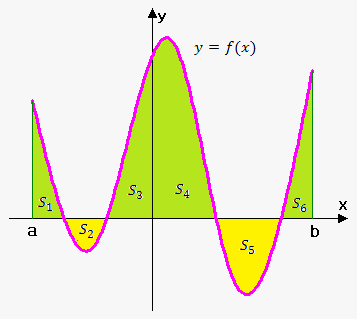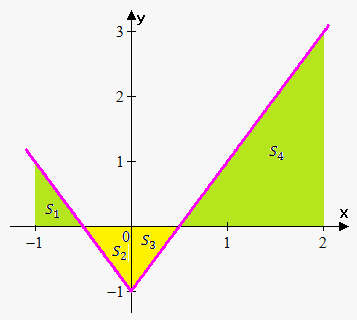Concept of Definite Integral
In the Area Problem note, we saw that the limit of the form $$$\lim_{{{n}\to\infty}}{f{{\left({{x}_{{i}}^{{\star}}}\right)}}}\Delta{x}$$$ arises when we compute an area.
It turns out that the same type of limit occurs in a wide variety of situations even when $$${f{}}$$$ is not necessarily a positive function.
Thus, this limit has a special name and notation.
Definition of Definite Integral. If $$$f$$$ is a continuous function defined for $$${a}\le{x}\le{b}$$$, we divide the interval $$${\left[{a},{b}\right]}$$$ into $$${n}$$$ subintervals of equal width $$$\Delta{x}=\frac{{{b}-{a}}}{{n}}$$$. We let $$${x}_{{0}}{\left(={a}\right)},{x}_{{1}},{x}_{{2}},\ldots,{x}_{{n}}{\left(={b}\right)}$$$ be the endpoints of these subintervals and we choose the sample points $$${{x}_{{1}}^{{\star}}},{{x}_{{2}}^{{\star}}},\ldots,{{x}_{{n}}^{{\star}}}$$$ in these subintervals, so that $$${{x}_{{i}}^{{\star}}}$$$ lies in the $$$i$$$-th subinterval $$${\left[{x}_{{{i}-{1}}},{x}_{{i}}\right]}$$$. Then, the definite integral of $$${f{}}$$$ from $$${a}$$$ to $$${b}$$$ is $$${\int_{{a}}^{{b}}}{f{{\left({x}\right)}}}{d}{x}=\lim_{{{n}\to\infty}}{\sum_{{{i}={1}}}^{{n}}}{f{{\left({{x}_{{i}}^{{\star}}}\right)}}}\Delta{x}$$$.
As with the indefinite integral, $$${f{{\left({x}\right)}}}$$$ is called the integrand.
$$${a}$$$ is the lower limit, and $$${b}$$$ is the upper limit.
Note that the definite integral is a number, it doesn't depend on $$${x}$$$. We can choose another variable: $$${\int_{{a}}^{{b}}}{f{{\left({x}\right)}}}{d}{x}={\int_{{a}}^{{b}}}{f{{\left({t}\right)}}}{d}{t}={\int_{{a}}^{{b}}}{f{{\left({u}\right)}}}{d}{u}$$$.
The sum $$${\sum_{{{i}={1}}}^{{n}}}{f{{\left({{x}_{{i}}^{{\star}}}\right)}}}\Delta{x}$$$ is called the Riemann sum.
If the sample points $$${{x}_{{i}}^{\star}}$$$ are the left endpoints, then the sum is called the left Riemann sum; if they are the right endpoints, the sum is called the right Riemann sum.
Now, let's see what will be if $$${f{}}$$$ can take both positive and negative values.
If $$${f{}}$$$ takes on both positive and negative values, then the Riemann sum is the sum of the areas of the rectangles that lie above the x-axis minus the sum of the areas of the rectangles that lie below the x-axis.
Thus, the definite integral is the net area: the area above the x-axis minus the area below the x-axis:
$$${\int_{{a}}^{{b}}}{f{{\left({x}\right)}}}{d}{x}={S}_{{1}}-{S}_{{2}}+{S}_{{3}}+{S}_{{4}}-{S}_{{5}}+{S}_{{6}}$$$.
Note that, although we defined $$${\int_{{a}}^{{b}}}{f{{\left({x}\right)}}}{d}{x}$$$ by dividing the interval $$${\left[{a},{b}\right]}$$$ into $$${n}$$$ intervals of equal width, it is sometimes advantageous to work with intervals of unequal width. If the subinterval widths are $$$\Delta{x}_{{1}},\Delta{x}_{{2}},\ldots,\Delta{x}_{{n}}$$$ then we have to ensure that all these widths approach $$$0$$$ in the limiting process. This happens if the largest width, $$$\max\Delta{x}_{{i}}$$$, approaches $$$0$$$. So, in this case, the definition of integral becomes $$${\int_{{a}}^{{b}}}{f{{\left({x}\right)}}}{d}{x}=\lim_{{\max\Delta{x}_{{i}}\to{0}}}{\sum_{{{i}={1}}}^{{n}}}{f{{\left({{x}_{{i}}^{{\star}}}\right)}}}\Delta{x}_{{i}}$$$.
Now, let's go through a couple of examples.
Example 1. Express $$$\lim_{{{n}\to\infty}}{\sum_{{{i}={1}}}^{{n}}}{\left[{3}{{x}_{{i}}^{{2}}}-{\cos{{\left({{x}_{{i}}^{{5}}}\right)}}}\right]}\Delta{x}$$$ as an integral on the interval $$${\left[{0},\pi\right]}$$$.
Comparing the given limit with the limit in the definition of integral, we see that they will be identical if we choose $$${f{{\left({x}\right)}}}={3}{{x}}^{{2}}-{\cos{{\left({{x}}^{{5}}\right)}}}$$$ and $$${{x}_{{i}}^{{\star}}}={x}_{{i}}$$$ (so that the sample points are the right endpoints). We are given that $$${a}={0}$$$ and $$${b}=\pi$$$; therefore, $$$\lim_{{{n}\to\infty}}{\sum_{{{i}={1}}}^{{n}}}{\left[{3}{{x}_{{i}}^{{2}}}-{\cos{{\left({{x}_{{i}}^{{5}}}\right)}}}\right]}\Delta{x}={\int_{{0}}^{\pi}}{\left({3}{{x}}^{{2}}-{\cos{{\left({{x}}^{{5}}\right)}}}\right)}{d}{x}$$$.
It is very important to recognize the limits of sums as integrals. In general, if $$$\lim_{{{n}\to\infty}}{\sum_{{{i}={1}}}^{{n}}}{f{{\left({{x}_{{i}}^{{\star}}}\right)}}}\Delta{x}={\int_{{a}}^{{b}}}{f{{\left({x}\right)}}}{d}{x}$$$, we replace $$$\lim\sum$$$ by $$$\int$$$, $$${{x}_{{i}}^{{\star}}}$$$ by $$${x}$$$ and $$$\Delta{x}$$$ by $$${d}{x}$$$.
Once it is clear, let's move on.
Example 2. Evaluate $$${\int_{{0}}^{{2}}}{\left({3}{{x}}^{{2}}-{{x}}^{{3}}\right)}{d}{x}$$$.
Divide interval $$${\left[{0},{2}\right]}$$$ into $$${n}$$$ subintervals of the width $$$\Delta{x}=\frac{{{2}-{0}}}{{n}}=\frac{{2}}{{n}}$$$.
Since we can use any point within a subinterval, let's use the right endpoints.
The right endpoint of the $$$i$$$-th subinterval is $$$\frac{{{2}{i}}}{{n}}$$$; so,
$$${\int_{{0}}^{{2}}}{\left({3}{{x}}^{{2}}-{{x}}^{{3}}\right)}{d}{x}=\lim_{{{n}\to\infty}}{\sum_{{{i}={1}}}^{{n}}}{f{{\left(\frac{{{i}}}{{n}}\right)}}}\frac{{2}}{{n}}=\lim_{{{n}\to\infty}}{\sum_{{{i}={1}}}^{{n}}}{\left({3}{{\left(\frac{{{2}{i}}}{{n}}\right)}}^{{2}}-{{\left(\frac{{{2}{i}}}{{n}}\right)}}^{{3}}\right)}\frac{{2}}{{n}}=\lim_{{{n}\to\infty}}{\sum_{{{i}={1}}}^{{n}}}{\left({24}\frac{{{i}}^{{2}}}{{{n}}^{{2}}}-{16}\frac{{{i}}^{{3}}}{{{n}}^{{3}}}\right)}\frac{{1}}{{n}}=$$$
$$$=\lim_{{{n}\to\infty}}{\sum_{{{i}={1}}}^{{n}}}{\left(\frac{{24}}{{{n}}^{{3}}}{{i}}^{{2}}-\frac{{16}}{{{n}}^{{4}}}{{i}}^{{3}}\right)}=\lim_{{{n}\to\infty}}{\left({\sum_{{{i}={1}}}^{{n}}}{\left(\frac{{24}}{{{n}}^{{3}}}{{i}}^{{2}}\right)}-{\sum_{{{i}={1}}}^{{n}}}{\left(\frac{{16}}{{{n}}^{{4}}}{{i}}^{{3}}\right)}\right)}=\lim_{{{n}\to\infty}}{\left(\frac{{24}}{{{n}}^{{3}}}{\sum_{{{i}={1}}}^{{n}}}{{i}}^{{2}}-\frac{{16}}{{{n}}^{{4}}}{\sum_{{{i}={1}}}^{{n}}}{{i}}^{{3}}\right)}=$$$
On this stage, we need the following two formulas:
$$${\sum_{{{i}={1}}}^{{n}}}{{i}}^{{2}}=\frac{{{n}{\left({n}+{1}\right)}{\left({2}{n}+{1}\right)}}}{{6}}$$$.
$$${\sum_{{{i}={1}}}^{{n}}}{{i}}^{{3}}={{\left(\frac{{{n}{\left({n}+{1}\right)}}}{{2}}\right)}}^{{2}}$$$.
So, $$${\int_{{0}}^{{2}}}{\left({3}{{x}}^{{2}}-{{x}}^{{3}}\right)}{d}{x}=\lim_{{{n}\to\infty}}{\left(\frac{{24}}{{{n}}^{{3}}}\frac{{{n}{\left({n}+{1}\right)}{\left({2}{n}+{1}\right)}}}{{6}}-\frac{{16}}{{{n}}^{{4}}}{{\left(\frac{{{n}{\left({n}+{1}\right)}}}{{2}}\right)}}^{{2}}\right)}=$$$
$$$=\lim_{{{n}\to\infty}}{\left(\frac{{{4}{\left({n}+{1}\right)}{\left({2}{n}+{1}\right)}}}{{{n}}^{{2}}}-\frac{{{4}{{\left({n}+{1}\right)}}^{{2}}}}{{{n}}^{{2}}}\right)}=$$$
$$$=\lim_{{{n}\to\infty}}{\left({4}{\left({1}+\frac{{1}}{{n}}\right)}{\left({2}+\frac{{1}}{{n}}\right)}-{4}{\left({1}+\frac{{2}}{{n}}+\frac{{1}}{{{n}}^{{2}}}\right)}\right)}={4}{\left({1}+{0}\right)}{\left({2}+{0}\right)}-{4}{\left({1}+{2}\cdot{0}+{0}\right)}={4}$$$
Thus, $$${\int_{{0}}^{{2}}}{\left({3}{{x}}^{{2}}-{{x}}^{{3}}\right)}{d}{x}={4}$$$.
This is going to become clearer with some more practice.
Example 3. Evaluate the following integral by interpreting it in terms of areas: $$${\int_{{-{2}}}^{{2}}}\sqrt{{{4}-{{x}}^{{2}}}}{d}{x}$$$.
Since $$${f{{\left({x}\right)}}}=\sqrt{{{4}-{{x}}^{{2}}}}\ge{0}$$$, we can interpret this integral as the area under the curve $$${y}=\sqrt{{{4}-{{x}}^{{2}}}}$$$ from $$$-2$$$ to $$$2$$$.
Squaring both sides gives $$${{y}}^{{2}}={4}-{{x}}^{{2}}$$$; then, $$${{x}}^{{2}}+{{y}}^{{2}}={4}$$$, and the required area is the area of the semicircle with the radius $$$2$$$.
Therefore, $$${\int_{{-{2}}}^{{2}}}\sqrt{{{4}-{{x}}^{{2}}}}{d}{x}=\frac{{1}}{{2}}\pi\cdot{{\left({2}\right)}}^{{2}}={2}\pi$$$.
Now, let's see our final example.
Example 4. Evaluate the following integral by interpreting it in terms of areas: $$${\int_{{-{{1}}}}^{{2}}}{\left({2}{\left|{x}\right|}-{1}\right)}{d}{x}$$$.
First, we draw the graph of the function $$${y}={2}{\left|{x}\right|}-{1}$$$ on the interval $$${\left[-{1},{2}\right]}$$$.
Recall that the definite integral is the net area: $$${\int_{{-{1}}}^{{2}}}{\left({2}{\left|{x}\right|}-{1}\right)}{d}{x}={S}_{{1}}-{S}_{{2}}-{S}_{{3}}+{S}_{{4}}$$$.
Now, the area $$${S}_{{1}}$$$ is the area of a right-angled triangle with the legs $$$\frac{{1}}{{2}}$$$ and $$$1$$$; so, $$${S}_{{1}}=\frac{{1}}{{2}}\cdot\frac{{1}}{{2}}\cdot{1}=\frac{{1}}{{4}}$$$.
Similarly, $$${S}_{{2}}=\frac{{1}}{{2}}\cdot\frac{{1}}{{2}}\cdot{1}=\frac{{1}}{{4}}$$$, $$${S}_{{3}}=\frac{{1}}{{2}}\cdot\frac{{1}}{{2}}\cdot{1}=\frac{{1}}{{4}}$$$, and $$${S}_{{4}}=\frac{{1}}{{2}}\cdot\frac{{3}}{{2}}\cdot{3}=\frac{{9}}{{4}}$$$.
So, $$${\int_{{-{1}}}^{{2}}}{\left({2}{\left|{x}\right|}-{1}\right)}{d}{x}=\frac{{1}}{{4}}-\frac{{1}}{{4}}-\frac{{1}}{{4}}+\frac{{9}}{{4}}={2}$$$.
